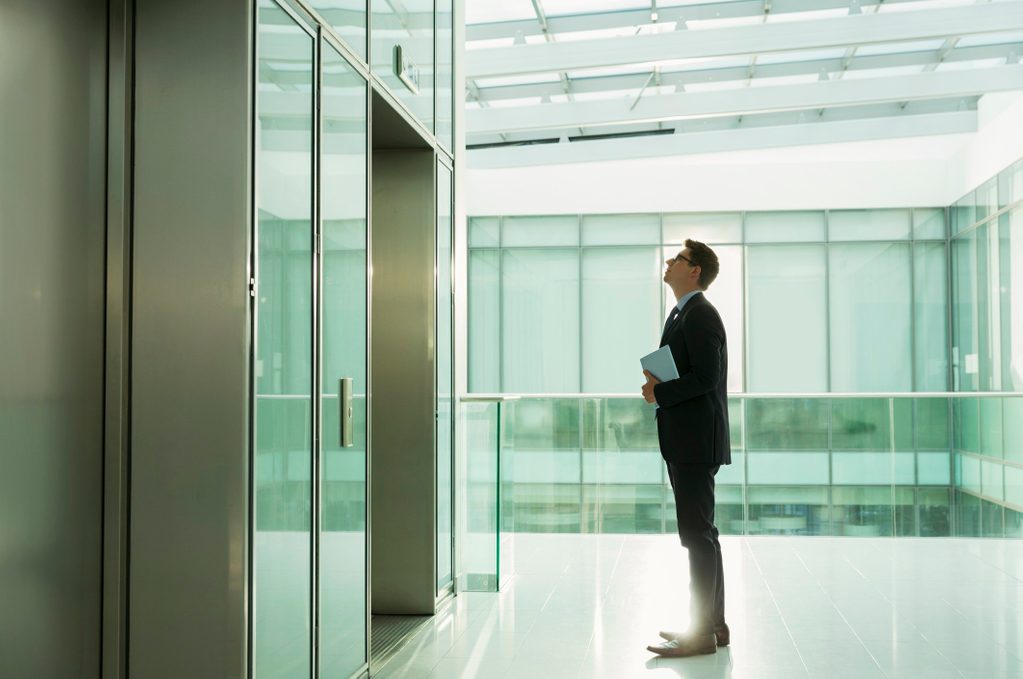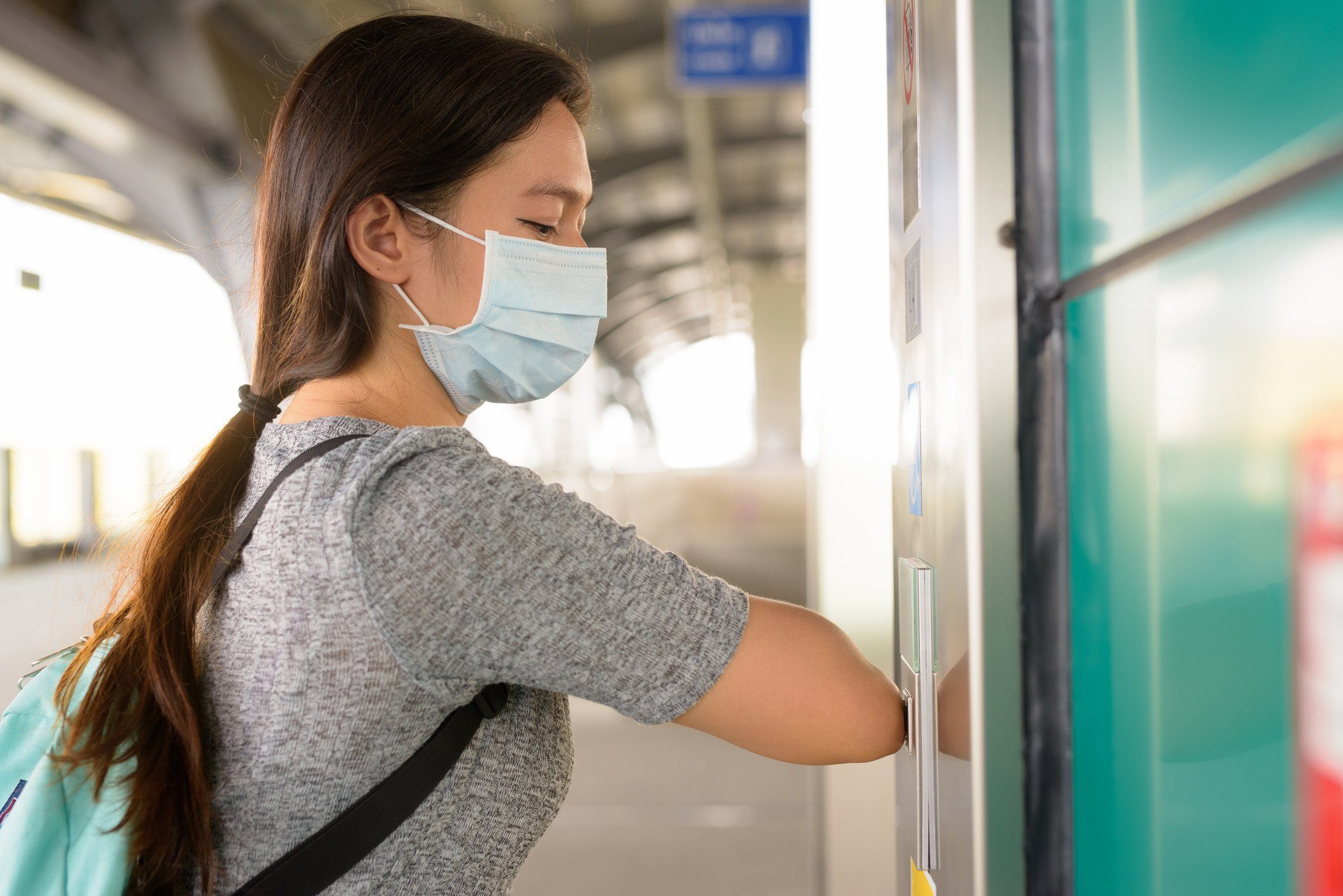How Can I Avoid Catching Coronavirus on an Elevator?

Going up? Take these measures to avoid coming down with COVID-19.
What’s the likelihood of catching COVID-19 on an elevator?
Here’s some good news: In an early release 2020 study published in Emerging Infectious Diseases focused on a COVID-19 outbreak in an office building in South Korea, the cases were mostly clustered among people who worked together on the 11th floor on one side of the building.
This is despite the fact that these employees came into contact with other people on different floors of the 19-story building (who shared the same elevators). Now, the researchers believe that since the spread of COVID-19 was mainly concentrated on the 11th floor, the risk for transmission is strongly contingent on the amount of time people interact or have contact with one another in a crowded, enclosed space, like a call centre. In other words, a 30-to-60 second elevator ride with an infected person may pose less of a risk than spending eight-plus hours hanging around an infected person in the same office.
According to the Centers for Disease Control and Prevention (CDC), the main way coronavirus spreads is through respiratory droplets from others close to us when they cough, sneeze, or talk; secondarily is touching contaminated surfaces (like elevator buttons) and then touching your face. Both are risks on elevators, although there aren’t specific studies yet on a person’s chance of contracting coronavirus in an elevator.
An April 2020 study published in Nature has suggested that aerosol droplets—which are smaller than respiratory droplets—may hang in the air in small, poorly ventilated spaces, but it’s still unclear what that means for the actual transmission of the virus. In the study conducted in two hospitals in Wuhan, China, levels of the virus were very low or undetectable in public areas, isolation rooms, and ventilated areas but were detectable in bathrooms used by patients. However, the potential for aerosol transmission depends on several factors, including the amount of the virus a person is exposed to. There isn’t enough research to determine if the amount of virus seen in the aerosol droplets was sufficient to cause an infection.
Try to social distance
The days of the crowded, uncomfortable elevator may be over. Buildings should “limit the number of people to be six feet [two metres] apart in an elevator,” says Patricia Whitley-Williams, MD, chief of pediatric allergy, immunology, and infectious diseases at Rutgers Robert Wood Johnson Medical School in New Brunswick, New Jersey. So it won’t be completely up to individual riders to decide what safe: It’s likely that your building will be instituting rules on how many people can fit in your building’s elevator, and even may place decals on the floor to indicate where people should stand and what direction to face. (Strange as it seems given the usual tendency for people to face forward in elevators, facing the walls may mean fewer droplets landing near your face).
Elevator makers and industry organizations are offering guidance for buildings on how to accomplish keeping people apart in elevators; depending on the size of the elevator, it might mean one person in each corner. In addition, reduced building capacity and recommended staggered arrivals, departures, and break times might help with long waits for the elevator. If you’re the only person on the elevator, that’s ideal, but in a large building that likely won’t be possible. If you aren’t sure how many people can safely fit in the elevator, ask your boss or building supervisor for better guidance.
Get off if you don’t feel safe
Still, “trying to keep six feet apart is challenging on an elevator,” says Suzanne Willard, clinical professor and associate dean of global health at the Rutgers School of Nursing in New Brunswick, New Jersey. “It’s difficult to do.” You can follow all the rules your building has set out, but what if others don’t? If you feel uncomfortable, get off the elevator,” Willard says. For example, if someone else tries to crowd in when there isn’t enough space left, you can remove yourself to avoid confronting them directly. Or, if you arrive to an elevator and it’s already full, don’t push in: Just wait for the next one.
“Avoid crowded elevators,” Dr. Whitley-Williams says. Leave plenty of time to get to work so you won’t feel rushed to catch the elevator. And don’t worry too much about social niceties, because you probably won’t be expected to hold the elevator—at least in the near future. (Here are more etiquette rules you can now ignore because of coronavirus.)
Wear a face mask
The best way to protect yourself on an elevator may be to wear a face covering. “Wearing masks are in order,” Willard says. A large systematic review of research published in June 2020 in The Lancet found that face masks are effective at protecting people against infection, especially if they’re N95 or similar respirators compared to disposable surgical masks or reusable cotton masks.
However, any mask is more effective than no mask at all, and the CDC recommends that people use cloth face masks when out in public, especially where social distance measures are difficult to maintain—which would include elevators. (Here’s how to make a DIY face mask, no sewing required!)
In addition, The Lancet review found that eye protection such as goggles or face shields may also help protect against transmission through the eyes, which the CDC lists as “possible” a way to get the virus.

Don’t touch elevator buttons
In addition, you can wear “gloves if you must touch anything,” Willard says. But, “for elevator buttons, an elbow usually does the trick.” (Then, change and wash your clothes when you get home.) Disposable gloves are only effective if you refrain from touching your face when wearing them, and if you remove them correctly right afterward without contaminating yourself; for these reasons, the CDC still doesn’t recommend wearing gloves for the general public. Another option is to use a tissue to press any buttons and then discard it right away. But a good way to protect yourself is simply to “use hand sanitizers and do hand-washing as much as possible,” Willard says. Don’t touch your face, and after you get off the elevator, wash your hands as soon as you get to your workplace. (Avoid these common hand washing mistakes.)
Don’t talk
Those awkward elevator moments are about to get even more awkward. A June 2020 study published in PNAS has shown that loud talking may actually lead to greater spread of the virus, so some companies and buildings are banning talking on elevators. This is our new etiquette, so don’t worry about feeling rude by avoiding small talk with your fellow riders.
Take the stairs if you can
Best yet, avoid the elevator altogether. “Take the stairs: We often have a saying, ‘Walk up a flight or down two flights instead of an elevator,” Willard says. “If you can walk, it’s great exercise.” This won’t be possible if you’re on the 30th floor, but consider it if you’re on the third—even if that means you take the elevator up but walk down. Start slow, and consider it a new fitness regimen.
“Risks may include fatigue if you are out of shape, but stair climbing is a great way to include exercise into your daily routines,” Willard says. “A friend of mine would climb 10 stories every day to her office when she came in.” That’s a lot, but do what you can. (Find out what happens when you start walking 10,000 steps a day.)
But stairs have risks, too
The CDC advises stairwells to be designated one-way, so hopefully, you won’t have to pass people in the opposite direction. Still, “stairs can also get crowded, so consider distance,” Willard says. Again, be careful of what you’re touching; use your elbow to open doors if you can and use the handrails only if needed for safety. “Wash your hands when you get to your destination, and until then don’t touch your face,” she says.
Next, find out the coronavirus mistakes to avoid this summer.






